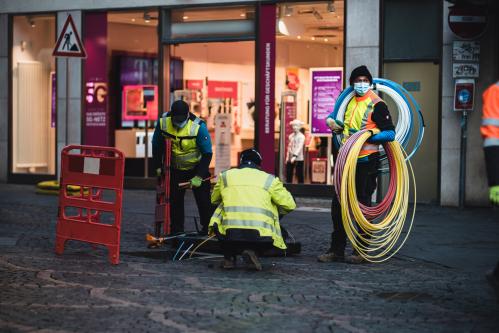This piece is a summary of the 2021-22 Olin Brookings Commission report to address opioid drug diversion issues. The full report of the Commission can be downloaded here.
The opioid epidemic has decimated many communities around the country. It has cost lives, harmed families, and upset the social fabric of a number of places. Around 69,700 people lost their lives in 2020 to opioid abuse in the United States.
To deal with this crisis, researchers at the Washington University Olin School of Business spent a year studying the issue and developing recommendations for mitigating the epidemic. Before an audience of policymakers, journalists, scientists, and healthcare professionals, these individuals and members of the Olin Brookings Commission outlined their solutions and recommendations to tackle troubling aspects of the opioid epidemic.
The six-member commission convened multiple times over the past 12 months and recently released a 53-page overview of the research process, policy recommendations and context—during an event at Brookings. The presentation outlined AI-driven tools to curb misdirection of opioid shipments and policy recommendations designed to facilitate the use of these tools.
“As I listen to the presentation, I have this sick feeling in my stomach, thinking if we had these tools 10 years ago, how many lives could we have saved?” said Van Ingram, one of the members of the Olin Brookings Commission and executive director of the Kentucky Office of Drug Control.
The group was the first convened by WashU Olin as part of a partnership with Brookings underwritten by The Bellwether Foundation. The project was designed to explore quality of life issues in communities and recommend policy changes to address them.
Focus on diversion of prescription drugs
The report tackled the opioid epidemic and, more specifically, the illicit diversion of prescription opioids that exploited blind spots in the distribution supply chain, fueling decades of dependency and death. Once researchers had zeroed in on a data-driven answer to that problem, the six-member commission devised a series of policy recommendations to facilitate their use.
“The blind spots still exist,” said Anthony Sardella, the chair of the commission and a member of the research team. “Our goal: Can you use data science to remove these blind spots? With that focus our research was begun.” (See a full list of the 2021-22 Olin Brookings Commission members on the commission’s website.) According to some reports, more than 100 billion prescription hydrocodone and oxycodone pills were distributed in the United States between 2006 to 2014.
An AI-driven solution
Olin researchers from the school’s Center for Analytics and Business Insights focused on the patterns of diversion within the drug supply chain using advances in data collection, data mining, artificial intelligence, and machine learning. The solution: Olin researchers developed a suite of anomaly detection tools to identify diversion trends in data submitted to a database maintained by the US Drug Enforcement Administration.
Using historical data from the Automation of Reports and Consolidated Orders System (ARCOS) database from 2006 to 2012, including more than 400 million opioid transactions and 277,000 buyers, researchers developed a tool to flag and stop fraudulent opioid shipments before they are diverted. The team identified patterns among likely diverters and tested their findings against a known database of convicted buyers.
The tool is designed to flag future diverters with 100% precision accuracy (i.e., if the tool flags a buyer as a diverter, it is almost guaranteed that the prediction is correct). In other words, the tool will not produce false positives. The team achieved that level of precision accuracy because the tool “lives with” a moderate degree (51%) of recall accuracy (i.e., the tool catches about one-in-two diverters). In other words, the team was willing to live with a higher rate of false negatives to ensure 100% precision accuracy in flagging likely diverters.
Values-based, data-driven work
“This work is emblematic of what WashU Olin Business School represents,” said Mark P. Taylor, the Olin dean who initiated the work to gain the Bellwether grant. “We’re dedicated to applying the rigorous use of data and the careful consideration of our principles to go beyond the bottom line, to address and impact critical issues in society.”
Once the research team locked down its anomaly detection tool, the 2021–22 Olin Brookings Commission developed a series of policy recommendations that, in combination, can overcome existing policy obstacles to empower industry and government to work together and implement the team’s near real-time detection and alert system to thwart opioid diversion in the supply chain.
The 14 recommendations include establishing a daily or near real-time pilot for integration of the anomaly detection tool to test the operational methods and modernizing the ARCOS technology infrastructure to support daily or near real-time data entry by registrants. And the work is not done. The research team intends to further refine its model to potentially look for additional flags—and even techniques for flagging the movement of nonprescription opioids.
“We can determine whether a transaction is supposed to happen or not,” said Annie Shi, a member of the research team and a marketing PhD student at WashU. “For example, if DEA receives a new transaction request, then our model will be able to predict if that transaction is supposed to happen or not. If it is predicted to be suspicious, the DEA will be able to hold off that shipment until further actions are taken.”







Commentary
Ways to address the opioid crisis
May 3, 2022